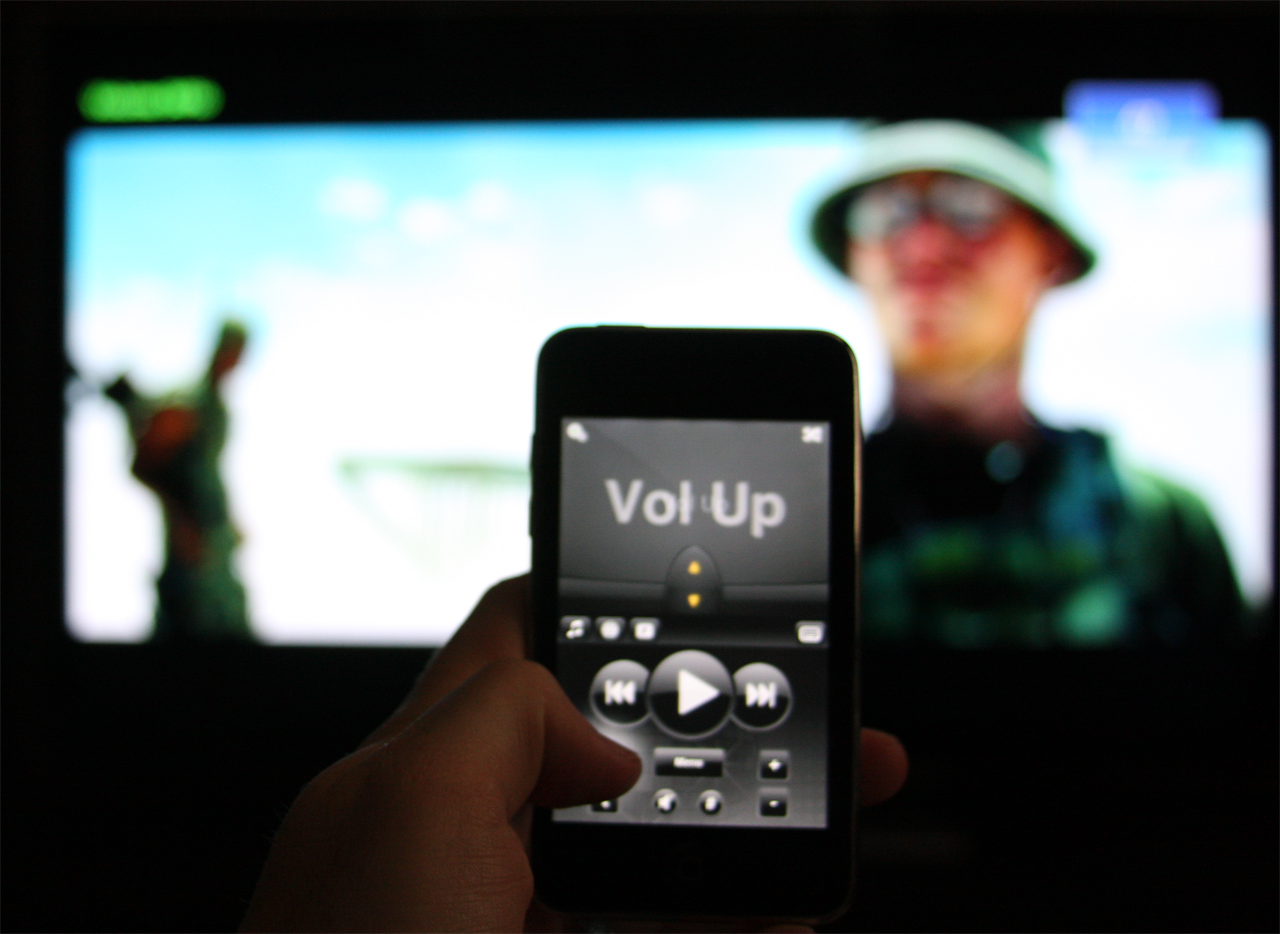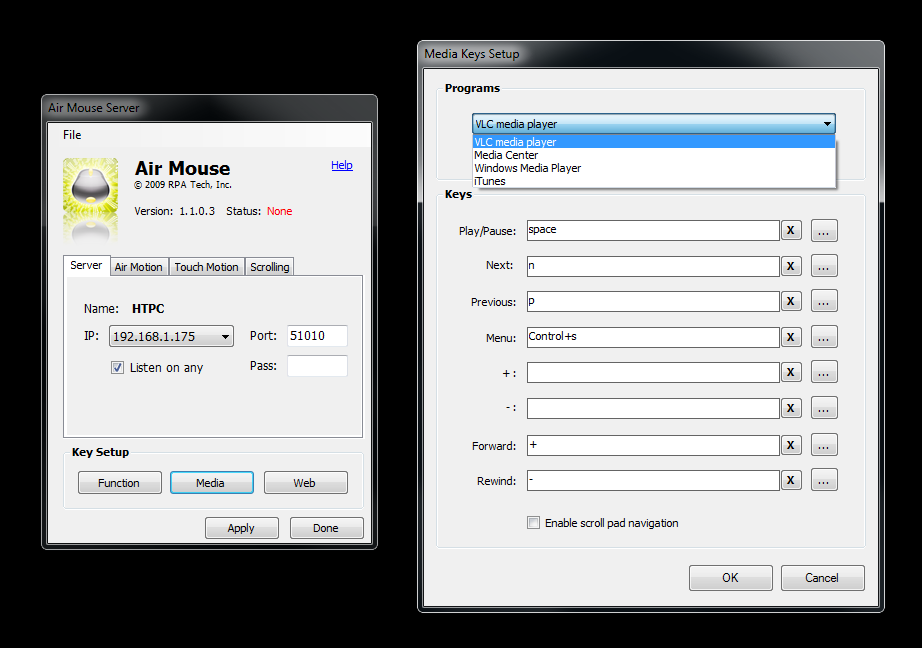The HTPC / Windows 7 Chronicles: You Asked, We Answer!
What’d You Use For A Remote Control?
This one came from reader barrychuck, who was curious about our remote control situation. Actually, barry recommended that we check out Ricavision’s much-hyped Vave 100 remote control based on Windows SideShow technology. However, emails to Ricavision went unanswered and, given a disconnected main phone line, we think it’s safe to say that the Vave died before a unit was ever even shipped. Too bad—looked like a cool product.
The Maui platform, as shipped from AMD, included a USB IR transceiver and a standard media center remote control with the same boring look as the units that’ve been around since 2005. Functional, but hardly flashy. Additionally, maintaining line of sight might be a problem for users with equipment tucked away in a rack.
On the same feedback page, heltoupee mentioned using an iPod Touch as a remote. So, I went out and bought a Touch in order to test the concept.
An App Store title called Mobile Air Mouse looked like the most promising solution for turning Apple’s audio/video player into a touch-screen remote. The software’s most notorious feature is tapping the accelerometer functionality built into both the iPhone and iPod Touch, letting you mimic a mouse in much the same way Gyration’s Air Mice have for years. More interesting to us, though, was that the software doubled as a track pad with four separate layouts: function keys, Web browser control, a standard keyboard, and a media-oriented layout. Right now the software works over WiFi, but we're hoping that it'll soon take advantage of the recently-enabled Bluetooth functionality on the Touch as well.
Why does the Air Mouse trump a standard media center remote? The touchpad functionality means you don’t need a mouse, and the built-in keyboard means you can do away with that peripheral, too.
Granted, a $200+ iPod Touch makes for an expensive remote control, as does a $200+ iPhone with a monthly plan. For the folks who already own one or the other, though, $6 for the software through the App Store is ridiculously inexpensive coming from a world of $250 Harmony remotes.
We originally ran into issues using Mobile Air Mouse with our HTPC, but the problems turned out to be related to the integration of PowerDVD 8 and Windows Media Center. Upgrading to PowerDVD 9 or using ArcSoft’s TotalMedia Theatre instead fixed those initial speed bumps. For use with video playback, Mobile Air Mouse works well. We had a bit more trouble with the software playing back music. While it behaved well in Windows Media Player proper, it didn’t want to follow directions in Windows Media Center. Not perfect, but certainly a step in the right direction.
Get Tom's Hardware's best news and in-depth reviews, straight to your inbox.
One other downside to going this route is the lack of universality enabled by a device like the Harmony One. In other words, you’ll still need to turn on your TV, pick the right source, turn on your receiver, pick the right input, and turn on your PC. But as a replacement for the boring (and functionally-limited) Media Center Remote with which our Maui box shipped, the iPod is a suitable substitute. Kudos to heltoupee for the suggestion—this one turned out to be a real winner in the face of Ricavision’s dead Vave.
Current page: What’d You Use For A Remote Control?
Prev Page Give Me Discrete Graphics Next Page Amp Up: Give The MSI Five Channel Card A Shot-
WheelsOfConfusion Nice follow-up. A bit more entertaining than benchmarking the same suite of games over and over, I'll bet.Reply
Unfortunately you ran into that DRM breakdown problem, where one snagged link in the hardware/software chain negated the high-quality features we're supposed to be enjoying through "easy" and "transparent" copy protection schemes. DRM will make criminals of us all, one way or another: if not by trying to get around it, then when we go on a bloody rampage out of frustration from trying to make it work. -
mcboj Nice article. Made for a good read, as I'm wanting to build a HTPC very soon. Seems crazy that the combined might of all these manufacturers aren't able to make this work 100% yet. Too many cooks in the kitchen?Reply -
Luscious Great article. I've been looking into getting BD content onto a HTPC but have run into the same DRM and audio issues as you describe. DVD's were a lot easier to deal with, but BD is an entirely different animal. True, I've yet to experiment with Win7 and have only touched Vista and MCE so far. I'm probably going to wait a few more months for Win7 to show before I look into it further.Reply
I do agree in your choice of a dedicated receiver. I've got an Onkyo receiver connected to Yamaha speakers in a 7.1 arrangement that I use primarily as a source switch. Originally I had three DVD changers that I replaced with a HTPC. It's worked well, but now with a growing BD library I need to take a second look at my system. Unlike you, however, I chose to go with a dedicated gaming box alongside with passive PSU, passive GPU and a silent CPU heatsink for big-screen gaming. The multiple HDMI and audio inputs on the receiver helped out big time. I also have a dedicated BD player at the moment that I'll probably keep just in case. -
empstar Hi I'm new to HDTV or HDPC I'm using the laptop(HP media DV1125 C2D, ATI 4650) to connect to my SONY 32" LCD TV 100MHz motion flow (32W550 just bough it on 04july09) using HDMI cable 1920x1024 Max Res. but the picture/win desktop look ugly and the front in the windows exploere lookReply
ugly too. Q1) how to SET? the best res? and Q2) should I use HDMI or PC-input (D-Sub 15 pin) to connect? DVD player connected to watch movie look great. HELP... some one? -
quadrophenia I thought I read somewhere that Maui does not work if you don't have an HD tv. Can anyone confirm this? ThanksReply -
kazius There are a lot of factors that you didn't factor in: room acoustics, speaker quality, speaker placement (NEVER place the speakers directly in the corner - like as seen in the pictures), and so on. These make the audio comparison a moot point - I'd expect a richer low end may actually harm the overall listening experience in such a setup, inaccurate spectral positioning, and a somewhat muffled/smudged sound.Reply
... Of course, nearly everyone makes these mistakes, because even home theater and PC enthusiasts tend to think that like the screen or PC, higher quality components is all you actually need for better results... which is true only after you solve all the acoustic issues in your setup. -
profundido Dear Tom,Reply
I have started my quest for the holy grail of htpc 2 years ago and have found it about a month ago. I set for myself the following requirements:
-it must be 1 box that is able to handle ALL available media
-it must be user friendly and relative dummy proof: no switching audio formats and settings in between movies, just press play and experience the magic (a typical non-tech minded person must be able to play it all)
-it must serve as TV-VCR in it's highest possible quality
-the audio quality must be at high end hifi quality in such a degree that if you play FLAC from it professional hifi dealers are blown away
-video must be full-HD
-it must be able to play current videogames fluent in full-hd res
-it must be able to handle all bluray audioformats flawlessly including dts-hd, master and LPCM WITHOUT HAVING TO SET ANYTHING OR SWITCH ANYTHING in the settings of the htpc
-it must appear and look like a receiver, not like a pc in the living room
-the surround sound must meet THX reference standards and volume
my quest led me through (funny) the exact same products and their respective problems among many others. I was able just like you to get the digital passthrough to work with the Xonar 1.3 deluxe but with that card a few problems remain such as having to switch standards before playing it in the Xonar console, malformed LPCM that sounds flattened and lacking bass etc and last but not least the very slow hdmi-video switching of all Onkyo receivers so that wasn't perfect. Then I went to a hi end hifi seminar and listened to the professional audiocard of Onkyo and was totally blown away by the amazing crystal clear sound quality it produces in combination with a proper receiver that amplifies the channels seperately in a fully analogue way. That's when the light hit me. I rebuilt my entire htpc concept around this "analogue" setup and left the trail of the "immature hdmi" path. The result was amazing. 1 time calibration with the aid of Vista Ultimate built-in room correction and I was in the middle of the best htpc experience I had ever witnessed. I'm so happy with the result since it meets all the criteria of the holy grail. I also store and stream bluray content in full size on a 6.5TB windows drive at the speed of full gigabit (RAID 8*1TB) and play it with Arcsoft TMT 3. High dev TV functionality is provided with Firedtv, an austrian solution that allows digital satellite HD streams to be displayed directly on the pc with a modified version of DVB viewer as software (more userfriendly). For the analog amplification And all that in a fusion remote case from Antec é voila, there's your holy grail in a slim slick box ;) -
profundido correction of missing part in above reply: For the analogue amplification of all 7.1 channels at THX ultraplus 2 standards and the volume of dolby reference I use the Onkyo 906 networkreceiver with 200watt per channel. Once the setup is calibrated, nothing else has to be done or switched on the receiver except volume control.Reply -
swt_2k Great information in this article "The HTPC / Windows 7 Chronicles: You Asked, We Answer!”Reply
Like most Media Center software users, I wanting to see a Digital PCI tuner card certify by Cablelabs; I don’t like to set top cable box. By-the-way, you cannot find the "ATI TV Wonder Digital Cable Tuner" anywhere. Sony no long lists that item. Also that item only uses the 1.0 unidirectional cable cards as opposed to the new 2.0 bi directional cable cards. Cablelabs is too slow bringing a digital cable card solution to the market.
Does any know when or where I can buy a digital tuner like the ones in current LCD TVs?
-
Shadow703793 Not sure if this was out when this was written, but there are PASSIVELY cooled 4670s. For example: http://www.newegg.com/Product/Product.aspx?Item=N82E16814102816Reply


